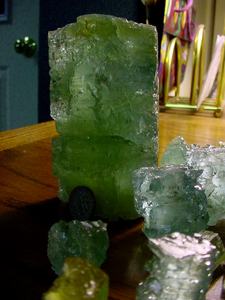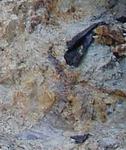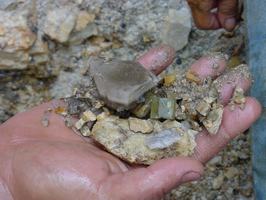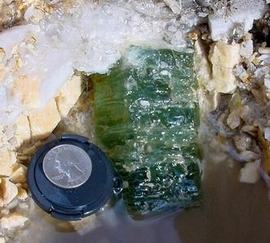
Blue ice?
Pockets with Etched Beryls
August 7:
We decided to gamble on a sinking blast into the pit floor west (towards
the front) of the productive zone. 18 holes were drilled to a depth of
4-6' depending on their location in the pattern. A constrained or pinched
in blast like this one is always more difficult as the material has no
relief-no place to go- and tends to be ejected with more violence. In this
case straight up. We knew that if anything were to appear in this zone
it would be badly damaged. The results of this blast yielded little in
the way of beryl or other interesting minerals. It did show that the zone
under our feet consisted of very large microclines with massive quartz
pods. No pockets were evident. The main advantage of this blast though
was we could now look at the floor under the productive zone without the
constant aggravation of standing water. It was now collecting in depression
made in the floor.
August 8:
As can be seen in this image from the 6th we still had one bench left
in the headwall. As the floor looked uninteresting -we were dead wrong-,
we decided to take this bench. While drilling above this remaining bench we had hit some small pockets.
Of the ones exposed, their contents consisted only of quartz crystals.
Drilling the back bench we did not seem to touch any pockets.
While drilling above this remaining bench we had hit some small pockets.
Of the ones exposed, their contents consisted only of quartz crystals.
Drilling the back bench we did not seem to touch any pockets.
After the blast this segment of the pit was cut cleanly away and lay
on the bottom . A few green beryls in matrix were evident. However more
quartz pockets were showing up in the headwall at this level. Some
extended quite far back into the pegmatite. On Sunday the 6th while Doug
was loading our dump truck and the pit was still quite full of water as
it is every morning, I noticed clean water slowly exiting a drill
hole in the pit floor. There was about 1' of muddy  water
above this hole and the clean water clearly could be seen emerging and
mixing with the muddy. Was this just another seam or perhaps there was
a cavity present below? In the pit images you can see a pod of quartz in
the bit floor just below the tar paper hole plug. The drill hole was on
the margin of the pod. water
above this hole and the clean water clearly could be seen emerging and
mixing with the muddy. Was this just another seam or perhaps there was
a cavity present below? In the pit images you can see a pod of quartz in
the bit floor just below the tar paper hole plug. The drill hole was on
the margin of the pod.
|
 Deciding
that this blast had yielded little, we brought in the excavator to scrape
out the debris. During this process we noticed the tell tale rusty-muddy
material showing up. We immediately switched from diesel to man power to
continue the clearance. We had discovered a pocket in the very bottom of
the bench that was filled with smoky quartz crystals and beryl. Soon we
were at work we bare hands and our 'pickers' evaluating every piece. Here
Doug is admiring the latest piece while Mary reaches for another. One of
the 36 year old diamond screens from Venezuela can be seen in the image
accumulating the material. Just to the left of the screen are the
'pickers'. All of the material from a pocket is precious and is thoroughly
screened for small minerals. Often apatite and bertrandite as well
as pristine acicular beryls show up in the fines. Deciding
that this blast had yielded little, we brought in the excavator to scrape
out the debris. During this process we noticed the tell tale rusty-muddy
material showing up. We immediately switched from diesel to man power to
continue the clearance. We had discovered a pocket in the very bottom of
the bench that was filled with smoky quartz crystals and beryl. Soon we
were at work we bare hands and our 'pickers' evaluating every piece. Here
Doug is admiring the latest piece while Mary reaches for another. One of
the 36 year old diamond screens from Venezuela can be seen in the image
accumulating the material. Just to the left of the screen are the
'pickers'. All of the material from a pocket is precious and is thoroughly
screened for small minerals. Often apatite and bertrandite as well
as pristine acicular beryls show up in the fines.
We continued working this pocket for about 2 hours. The pickings were
getting slim and the debris mound was becoming a nuisance. Much to Mary's
consternation we decided to bring the excavator back in and remove the
last of the blast debris laying on the bench. While my approach is much
more 'production' oriented Mary wanted to continue to work the pocket. Soon Doug and I were alone in the pit. Taking only a few minutes to do
the final removal, Doug and I were back in with our hoes. Hoeing across
a quartz pod sandwiched between microclines, smoky quartz plates began
flaking off. Soon smokies were coming out by the handfuls. Lamenting to
Doug that this may only be a quartz pocket, Doug reached in and extracted
an etched aquamarine of a fine blue color. I called Mary at our 'mine shack'
to reconsider her decision to leave. Her mind unfortunately was set. Continuing
to work the pocket, we pulled back a quartz plate to reveal a huge etched
beryl laying in the pocket. Again I called Mary and this time she relented
and agreed to return. The landowners, the Bennetts, were called as well
to
Soon Doug and I were alone in the pit. Taking only a few minutes to do
the final removal, Doug and I were back in with our hoes. Hoeing across
a quartz pod sandwiched between microclines, smoky quartz plates began
flaking off. Soon smokies were coming out by the handfuls. Lamenting to
Doug that this may only be a quartz pocket, Doug reached in and extracted
an etched aquamarine of a fine blue color. I called Mary at our 'mine shack'
to reconsider her decision to leave. Her mind unfortunately was set. Continuing
to work the pocket, we pulled back a quartz plate to reveal a huge etched
beryl laying in the pocket. Again I called Mary and this time she relented
and agreed to return. The landowners, the Bennetts, were called as well
to  witness
this find in the pocket. Although it seemed like eternity , eventually
the cast gathered for the extraction. The beryl was not attached at all
for it was later found the it had become dislodged from its feldspar attachment
about 1 foot further back in the pocket. The crystal was quite etched
but the upper 1/3 of this 3300 carat specimen was fine gem. The gemmy end
can be seen extending into the water. This pocket was found at about 3
in the afternoon. At sunset were were still removing beryl from its recesses.
In fact this process continued sporadically for 2 more days. witness
this find in the pocket. Although it seemed like eternity , eventually
the cast gathered for the extraction. The beryl was not attached at all
for it was later found the it had become dislodged from its feldspar attachment
about 1 foot further back in the pocket. The crystal was quite etched
but the upper 1/3 of this 3300 carat specimen was fine gem. The gemmy end
can be seen extending into the water. This pocket was found at about 3
in the afternoon. At sunset were were still removing beryl from its recesses.
In fact this process continued sporadically for 2 more days.
Page 3-Visitors to the Orchard
Mine-more stuff comes out
|